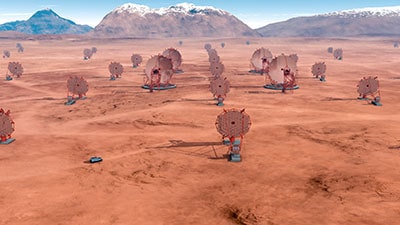
Sites in Spain and Chile have been chosen to host the Cherenkov Telescope Array (CTA) – a huge gamma-ray observatory 10 times more sensitive than existing instruments, which will study supernova explosions, binary star systems and active galactic nuclei. Astronomers working on the project expect they will get approval at the end of the year to start building the arrays. It is hoped that the CTA will begin taking data at both locations by the end of 2020, with full operations by 2023.
High-energy gamma rays are generated in the most energetic events in the universe, and studying these messengers can reveal important information about the violent processes that created them. When a gamma ray interacts with a particle in the Earth’s atmosphere, it produces a shower of lower-energy particles. These particles travel through the atmosphere faster than the speed of light in the atmosphere, creating a cone of blue light akin to a sonic boom. Telescopes on the ground collect this Cherenkov radiation, which scientists then analyse to determine the energy of the original gamma ray and from what direction it came.
The CTA will consist of two arrays. The smaller array – consisting of 15 telescopes 12 m in diameter and four at 23 m – will study the northern sky from the Spanish island of La Palma, which is off the Atlantic coast of North Africa. The larger observatory will have 70 telescopes at 4 m diameter, 25 at 12 m and four at 23 m. It will look toward the southern sky from Paranal in Chile’s Atacama Desert, and the first few small telescopes are likely to be deployed to the Chile site in mid-2016.
‘Excellent astronomical conditions’
According to CTA project manager and technical director Christopher Townsley, these two sites were chosen over other competitors for several reasons, including the level of existing infrastructure and the estimated long-term operation costs. “Both the sites chosen have well-established observatories nearby and proven excellent astronomical conditions,” Townsley explains. If for any reason the La Palma and Paranal site negations fall through, however, the group has alternative north and south locations in Mexico and Namibia, respectively.
The CTA will build on the technologies developed for current ground-based gamma-ray telescopes – such as the Very Energetic Radiation Imaging Telescope Array System in the US as well as the High Energy Stereoscopic System in Namibia – that use Cherenkov imaging techniques. Apart from being 10 times more sensitive than any rival, the CTA will also study a wider range of energies, from about 10 GeV to 300 TeV, although energies above 10 TeV will be accessible only with the southern site’s 4 m instruments.
Scientists plan to do two astronomical surveys with the CTA: one of the galactic plane that contains the galactic centre – a site swarming with high-energy sources – and the other of one-quarter of the full sky. The observatory could also shed light on dark matter, according to CTA spokesperson Werner Hofmann of the Max-Planck-Institute for Nuclear Physics in Heidelberg. He explains: “If dark matter is indeed made of neutralino particles in the TeV mass range, CTA is in the best position to detect this radiation – a discovery that would have tremendous impact and far-reaching consequences for astrophysics, particle physics and cosmology.”
The most exciting science that the next-generation gamma-ray detector can do, however, is uncovering new surprises. “When you build an instrument that is much more capable than existing instruments, and you’re exploring a new waveband,” says CTA co-spokesperson Rene Ong of the University of California, Los Angeles, “you’re going to discover something unexpected.”



